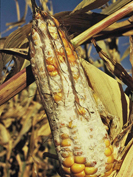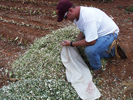David G. Schmale III
Virginia Polytechnic Institute and State University, Blacksburg, VA
Gary P. Munkvold
Iowa State University, Ames, IA
FUMONISINS
 |
|
Figure 9 |
 |
|
Figure 10 |
 |
|
Figure 11 |
The fumonisins are a group of mycotoxins produced primarily by Fusarium verticillioides and Fusarium proliferatum, although a few other Fusarium species also may produce them. Traditionally, Fusarium moniliforme is the fungal species associated with fumonisins, but this name is no longer used, due to advances in taxonomy and nomenclature. There are at least 28 different forms of fumonisins, most designated as A-series, B-series, C-series, and P-series. Fumonisin B1 is the most common and economically important form, followed by B2 and B3. Maize is the most commonly contaminated crop, and fumonisins are the most common mycotoxins in maize, although these toxins can occur in a few other crops as well. Fusarium verticillioides and fumonisins are distributed worldwide. The primary health concerns associated with fumonisins are acute (single exposure) toxic effects in horses and swine, and carcinogenic (able to cause cancer) properties. Horses that are poisoned with fumonisins may develop a fatal disease known as equine leukoencephalomalacia. Symptoms of this disease include drowsiness, blindness, staggering, and liquefaction of brain tissue [Figure 9]. Swine that are poisoned with fumonisins may experience reduced feed intake and weight gain, liver damage, and can develop a fatal disease known as pulmonary edema, in which the animals' lungs are filled with fluid. Fumonisins are carcinogenic to laboratory animals, and in humans, consumption of fumonisin-contaminated maize is associated with higher rates of esophageal cancer and neural tube birth defects. Fumonisins were first characterized in the late 1980s, as a result of studies into the causes of esophageal cancer in Africa, coupled with outbreaks of equine leukoencephalomalacia and porcine pulmonary edema in the U.S.
Fumonisin-producing Fusarium fungi cause a disease in maize known as Fusarium ear rot [Figure 10]. Fumonisins can contaminate grain used for human food or livestock feed, as well as silage [Figure 11]. Infection is increased if kernels are physically damaged, especially by insect feeding. Fungal growth and fumonisin production cease when grain is dried below about 19% moisture content, but the fumonisins remain intact, and the fungus can grow and produce additional fumonisins in storage if proper conditions are not maintained. Fumonisins can be found in a few other crops, typically at low levels, but their economic importance is mainly in maize.
Next: Ochratoxins
